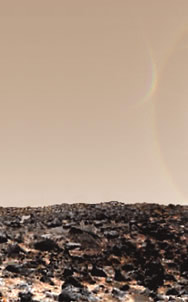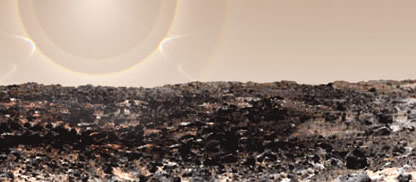
OPOD
What's New
Rays & Shadows
Water Droplets
Rainbows
Ice Halos
Contents
Crystals
Frequent Halos
Infrequent Halos
Multiple Displays
Other Worlds
Mars
CO2 Crystals
Jupiter
Saturn
Observing Halos
HaloSim
High Atmosphere
Links & Resources
Search - Index
123456789012345678
| Other Worlds |
|
|||||
| Halos formed by clouds of frozen carbon dioxide shine in a dusty Martian sky. Familiar water-ice crystals form the inner 22� halo. CO2 cuboctahedral crystals produce the next of 26� radius and the outer 39� halo is from octahedra and cuboctahedra. Cuboctahedral platelike crystals generate multiple parhelia and the bright uppermost arc. Painting & HaloSim3 simulation by Les Cowley | |||||
The thin Martian atmosphere is mostly carbon dioxide with only minute traces of water vapour. Each Martian year at the winter pole it gets cold enough (minus 123�C) that some of the atmosphere condenses into tall clouds of CO2, 'dry ice' crystals. As winter deepens, CO2 snow falls and covers the polar surface until springtime with a dense 2m thick layer. The wax and wane of the 'ice' caps can be watched from Earth with a small telescope. Could Mars have CO2 crystal halos? CO2 crystals are sufficiently transparent. They would also have to be reasonably large enough and optically good. Clouds over the winter pole are mostly in darkness but elsewhere, high in the atmosphere, it is sufficiently cold for cirrus like CO2 clouds. Many conditions need be met but Mars might sometimes have exotic and colourful halos quite unlike those of Earth. Michael Schroeder and myself used an early version of the HaloSim software to predict them and the Mars Polar Lander launched in January '99 was scheduled to search for halos as part of its multi-spectral sky imaging program. Observation of even fragments of halos would tell us more about Martian clouds and climate. However, after an 11 month voyage, contact with the Lander was lost after it entered the Martian atmosphere. We shall have to wait longer to see halos in the skies of another world ... More details in: Forecasting Martian Halos by Les Cowley & Michael Schroeder, Sky & Telescope, Dec '99. pp 60-4. 'Vorhersage von Mars-Halos', Meteoros, Jahrgang 3 Nr.6/2000 pp 103-8. |
|||||


